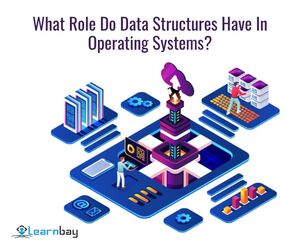What Role Do Data Structures Have In Operating Systems?
Body
Overview of the Operating System
The Operating System's job is to take user commands, employ hardware to carry out processes, and then give the user the results. Different OS functionalities include:
- It manages how different application programs are run.
- It stops a user from interfering with the hardware.
- It offers practical and effective procedures to ensure the computer system runs properly.
- It is in charge of planning and allocating resources and services like I/O units, memory, CPUs, etc.
- The privacy and security of user data and software are also under its control.
Operating systems include, for instance, Windows, macOS, Android, iOS, GNU/LINUX, and others.
Operating systems can be viewed as agents. For instance, we are purchasing airline tickets through a representative. We provide him with information such as the departure and boarding locations, the number of passengers, and other pertinent details. The agent will look into flights for that day and time, seat availability, the closest airport, price, etc. The most practical and convenient flight will then be used for his return. The agent will book our tickets as soon as we confirm, and we will receive them.
The same principle applies to OS; we will provide it with certain data and instruct it to carry out certain tasks. The resources, hardware, and memory will all be checked. The resources needed to finish the operation will then be allocated. When finished, It will provide the user with the output back.
Data Structure
Either values or groups of values comprise data. Unlike the logically connected representation of data, which produces fundamentally significant information, this raw data version is not particularly useful and has no value. We require strong and effective storage and organization mechanisms for the identification and storage of data. You can learn to master data structures with the help of a comprehensive data structures and algorithms course available online.
For storing and retrieving data quickly, we employ data structures. The data structure needs to handle the real-world relationships of data. On the other hand, it should be easy enough to efficiently organize, store, process, and retrieve data.
Stacks, Queues, LinkedLists, Maps, and other frequently used data structures are just a few examples. The data structures' hierarchical structure is seen below.
Applications of various Data Structures in Operating Systems
To plan tasks, store instructions, carry out operations, allocate and release memory, etc., the operating system uses a variety of data structures. Various data structures will be shown.
-
Array
A linear and homogeneous data structure is an array. In a single, continuous block of memory, they keep the data. It is relatively simple and serves as the foundation for all other data structures.
-
LinkedList
A homogeneous linear data structure is the linked list. It is made up of several nodes. Each node has two components: a data element and a link element. The data element and the link store the address to the following element's address. It arranges facts logically rather than chronologically. It is a beneficial data format for carrying out various operations tasks. Many different data structures are also implemented using it.
Application
- Operating systems employ linked lists for dynamic memory allocation and run-time memory release.
- Our browsers' BACK and NEXT buttons let us use LinkedList to go to the previous and following web pages. In doubly-linked lists, the website addresses are kept.
- Unbounded memory can be managed in a system easily with a linked list.
-
Stack
A linear and homogeneous data structure is a stack. Only one end, known as the TOP, is used to insert and remove the parts. The Last in, First Out (LIFO) principle governs its operation. Consider a stack as a stack of plates for an effective analogy. The only removable plate is the one at the top.
Application
- Local variables used inside a function block are stored in a stack data structure by the operating system or compiler so they can be destroyed once control leaves the function block.
- When you need to obtain the most recent data element in a list of elements, backtracking is a procedure that uses stacks.
- Function calls are handled using the Stack data structure, also used to build recursive functions. The last called function will initially return the value by popping the stack, pushing the function's return values and addresses into memory.
- Internally, as language is processed, a stack generates room for parameters and local variables. Check out the data structure course to familiarize yourself with the DSA concepts necessary to succeed as a developer.
-
Queues
A uniform linear data structure is the queue. The insertion and deletion of elements are accomplished using various endpoints. First In, First Out, or FIFO, is how it operates. At the front and back ends are entered and withdrawn elements. The line may be compared to the line at the ticket counter. The first person who arrives gets the item.
Application
- Operating systems employ queues to store interrupts.
- In the OS, synchronization is processed through the queue.
- Additionally, CPU and disc job scheduling both employ queues.
- The incoming data is stored there by an application program.
- Each task is given a time slot in a cyclic manner using the CPU scheduling mechanism known as round-robin scheduling. Queues are used to carry out this strategy. The usage of the circular queue applies the round-robin algorithm.
-
Trees
This data structure is called a tree. It is employed to group data objects according to keys or hierarchical relationships.
Application
- Trees are employed in many search applications where data is regularly added and removed, such as the maps, sets, etc., of several language libraries.
- The operating system keeps the disc's file system as a tree. When stored hierarchically, files and folders function as a tree node. Because it is simple to create and delete folders and files, or "nodes," a tree structure is utilized.
- The OS can use trees to quickly traverse and search directory structures on a machine.
-
Graphs
In non-linear data structures known as graphs, a limited number of ordered pairings of particular elements known as vertices or edges and arcs are stored. Graphs can be either directed or undirected. It is a beneficial data structure in resource allocation, scheduling, resource networking, database design, etc. These are all the capabilities of the operating system.
Application
CPU job scheduling uses graphs. The assumption is that jobs are the vertices of the graph and the edges between related jobs.
Graphs are also used to execute multiple jobs simultaneously on a group of processors.
It is possible to solve the issue of complex timetable scheduling effectively using graphs. At any given time, it is assumed that each professor can only teach one subject and that only one can teach any subject at any given time. Likewise, one processor can only handle one task at a time. Calculating the remaining tasks in the graph uses the best graph coloring algorithm.
If you are someone planning to learn software and web technologies, Learnbay has the best course in store for you. Visit the full stack software developer course in Delhi and kickstart your full stack career now!









Comments